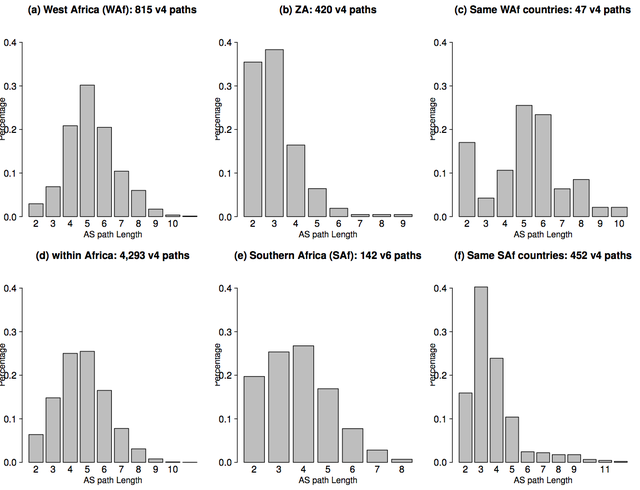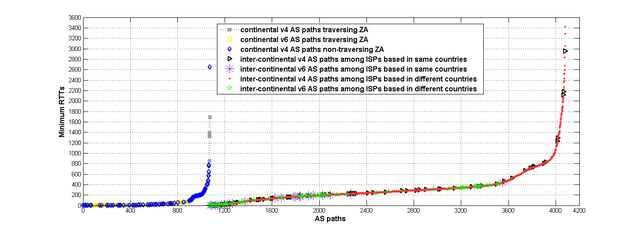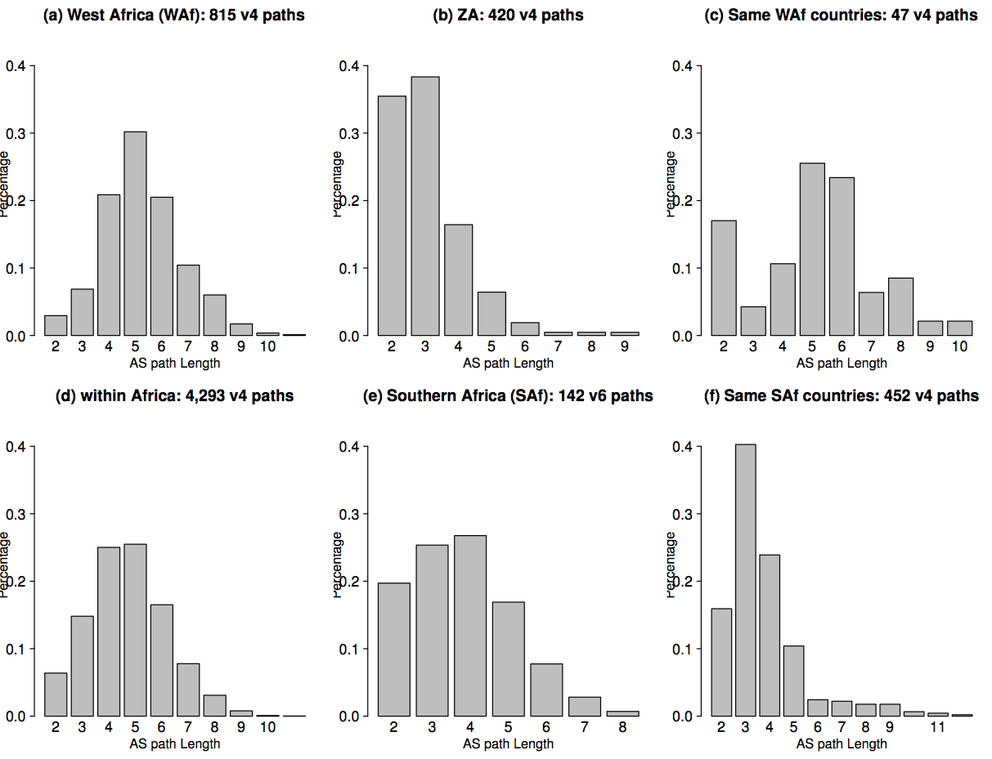In 2013 and 2014 we looked into measuring Interdomain Routing in Africa using the RIPE Atlas infrastructure. This resulted in a paper published at the PAM (Passive and Active Measurement) 2015 conference. Here we present some highlights of this research.
Introduction
As IP networking in Africa grows, we can use RIPE Atlas data to build a picture of IP transit topology on the continent. These results offer telling insights into ISP transit habits, the emergence of Internet Exchange Points (IXPs) in Africa and the role of ISPs based outside Africa.
Africa’s high spending on intracontinental transit fees has led to initiatives such as the African Internet eXchange System (AXIS) to promote the creation of local IXPs and to improve IP infrastructure. Comparatively little is known about the current state of Internet topology in Africa, due to its low representation in existing measurement projects.
In order to obtain a better picture of the Internet interconnection in Africa, we collaborated with numerous ISPs in Western and Central Africa to deploy RIPE Atlas probes in their networks.
Methodology
Our measurement campaign covered 6 months, monitoring end-to-end paths between IPv4 and IPv6 probes in Africa.
We significantly increased the RIPE Atlas coverage in Western Africa by deploying 21 RIPE Atlas probes in 15 ISP networks covering 11 countries in the region. Collaborating institutions, including AFRINIC and ISOC , along with RIPE Atlas ambassadors , also deployed a considerable number of probes in the Southern and Eastern regions, which we used in this study. We conducted three measurement campaigns:
- We performed traceroutes among all RIPE Atlas probes located in Africa, with a period of 3 hours, from 30 November 2013 until 6 April 2014.
- We issued IPv4 and IPv6 traceroutes, at the same frequency, focusing on countries hosting IPv6 enabled probes, from 1 June until 1 August 2014.
- During the second week of August 2014, we performed 3,161 hourly traceroutes among all RIPE Atlas probes in Gambia. This was done to highlight the launch of the Serekunda IXP in the country.
Results
The ISP transit habits we observed often correlate with the specifics of a nation's location, but also with its language and currency. Intra-continental paths in our data are dominated by ISPs based outside Africa, South Africa being the notable exception.

Figure 1 shows path length distributions for all paths and for some African regions. Following these results, we can see that there are unusually long AS paths in West African countries, whereas short paths tend to be found in the Southern Africa region (SAf) and in the country of South Africa (ZA) specifically.
Paths among ASes operating in the same country (Figures 1 (c) and (f)) are much shorter in South Africa than in West Africa. IPv6 AS paths, all observed in Southern Africa, tend to be short, reflecting similar peering and localised transit habits as for IPv4 in the region. These observations confirm that focusing solely on measurements from South Africa does not provide a representative sample of Internet path characteristics for the rest of Africa.
The four most central ( [1] ) ASes of the observed African IPv4 interdomain topology are all international ones: Level3 (US) with 23.4% of the AS paths studied, TATA (US) with 22%, Cogent (US) with 13.6% and Orange (FR) with 12%. 65.2% of the AS pairs were served using at least one of these four ASes. The most central African AS, Internet Solutions (ZA), has an AS-centrality of 11.6%. Orange is the dominating ISP when it comes to paths among ASes in the Western Africa category, with an AS centrality of 37.8%.
A relevant percentage of paths (18.9%) connecting West African ASes transit via MTN (ZA). The most central local AS is MainOne (NG), found on 17.2% of the paths.
Reliance on international transit providers is lowest in Southern Africa, where ASes appear to benefit from diversity in their transit offerings, access to IXPs, and resort to a lot of peering.
Some ASes that are not relevant for IPv4 routing show a high AS-centrality when it comes to IPv6. The top 3 ASes in IPv6 are Hurricane Electric (US) with 23.9%, TENET (ZA) with 22.5% and Liquid Telecom (GB) with 21.1%. They are followed by IXPs AS5459 (LINX-AS, GB) and AS1200 (AMSIX, NL) traversed respectively by 19.7% and 14.7% of the paths, while Level3 and TATA are present on only 9.8% and 9.1%.

Figure 2: Minimum RTT distribution
Figure 2 shows the distribution of the minimum RTTs among our probes. Continental paths are those for which the corresponding Country path traverse only African countries, while intercontinental ones traverse at least one country outside Africa. Continental paths with very low RTTs mostly correspond to paths among pairs of ASes based in the same country, or those passing through collocated regional ISPs. All the continental IPv6 paths traverse ZA.
Slightly longer RTTs (50-150ms) are seen among AS pairs from geographically distant countries. For instance, a path from a KE ISP to a ZA ISP, only served by African transit ISPs, shows a minimum RTT of 80ms.
Most of the measured RTTs in this category, however, reflect intercontinental transit of continental traffic, with an RTT around 200ms. 94.5% of the paths with an RTT between 100ms and 400ms lead through Europe. Paths with RTTs around 750ms run mostly from and towards ISPs that are served by satellite providers, routing traffic through another continent.
The paths measured with an RTT above 1000ms are mostly those served via 2 satellite links.
Emergence of new IXPs
In looking at the use of IXPs to exchange traffic, we notice some frequently-used IXPs, notably the Johannesburg Internet Exchange (JINX), the Cape Town Internet Exchange (CINX), the Durban Internet Exchange (DINX) and the NAP Africa in South Africa. 58.6% of the continental paths that traverse South Africa go through one of these IXPs.

Figure 3 illustrates the benefit to RTT brought by the presence of Benin-IX. From December 2013 to April 2014, RTTs measured among those ASes drop from average 314ms in late 2013 to average 42ms in early 2014. The graph depicts the RTT among two members of that IXP, as well as the length of the measured AS sequence. The figure also shows that our probes lost Internet connectivity during the establishment of the IXP, as very few traceroutes succeeded during that period.
Conclusions and future work
We’ve noticed striking differences in transit habits of ISPs, notably depending on the official language of the country, the monetary system, or the business profile of the ISP (details in the full paper). The results suggest it is critical to have a large, diversified set of vantage points before drawing conclusions on the state of interdomain routing on the African continent. Further increasing the number and diversity of RIPE Atlas probes in Africa would allow for increasingly detailed analysis of the interdomain routing on all of the African continent.
Our results show a lack of interconnection among African ISPs (South Africa being an exception), confirming the interest of initiatives to promote peering on the continent. New IXPs are emerging in Africa, notably in the West. The benefits can be seen in reduced latency between members of these IXPs.
In the future, we plan to measure the connectivity between African ISPs and the rest of the world. We also intend to provide a model to study the opportunities for cost reduction brought by IXP initiatives on the continent.
We are grateful to whoever deploys or hosts a RIPE Atlas probe.
For more information, you can download the full paper . Also see the technical report containing raw data for traceroutes and pings (issued for geolocation purposes) and further results and analyses.
Please note that Roderick Fanou will attend the RIPE 70 Meeting in Amsterdam as a fellow of the RIPE Acadamic Cooperation Initiative ( RACI ) and will present on this topic during the RACI BoF on 12 May 2015 at 18:00.
Footnote [1]: We define the concept of AS centrality which captures the centrality of a sequence of ASes present together in one AS path. See the full paper for the exact definition.


Comments 0
The comments section is closed for articles published more than a year ago. If you'd like to inform us of any issues, please contact us.